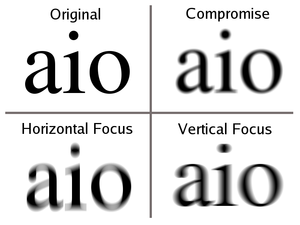Astigmatism
| Astigmatism | |
|---|---|
 |
|
| Blur from astigmatic lens at different distances | |
| Classification and external resources | |
| Specialty | Ophthalmology |
| ICD-10 | H52.2 |
| ICD-9-CM | 367.2 |
| OMIM | 603047 |
| DiseasesDB | 29648 |
| MedlinePlus | 001015 |
| MeSH | D001251 |
Astigmatism is a type of refractive error in which the eye does not focus light evenly on the retina. This results in distorted or blurred vision at all distances. Other symptoms can include eyestrain, headaches, and trouble driving at night. If it occurs early in life it can result in amblyopia.
The cause of astigmatism is unclear. It is believed to be partly related to genetic factors. The underlying mechanism involves an irregular curvature of the cornea or abnormalities in the lens of the eye. Diagnosis is by an eye exam.
Three options exist for the treatment: glasses, contact lenses, and surgery. Glasses are the simplest. Contact lenses can provide a wider field of vision. Refractive surgery permanently changes the shape of the eye.
In Europe and Asia astigmatism affects between 30 and 60% of adults. People of all ages can be affected. Astigmatism was first reported by Thomas Young in the early 1800s.
Although astigmatism may be asymptomatic, higher degrees of astigmatism may cause symptoms such as blurry vision, squinting, eye strain, fatigue, or headaches. Some research has pointed to the link between astigmatism and higher prevalence of migraine headaches.
In with-the-rule astigmatism, a minus cylinder is placed on the horizontal axis to correct the refractive error (or a plus cylinder in the vertical axis). Adding a minus cylinder in the horizontal axis makes the horizontal axis "steeper" (or better: makes the vertical axis "less steep") which makes both axes equally "steep". In against-the-rule astigmatism, a plus cylinder is added in the horizontal axis (or a minus cylinder in the vertical axis).
Axis is always recorded as an angle in degrees, between 0 and 180 degrees in a counter-clockwise direction. Both 0 and 180 degrees lie on a horizontal line at the level of the center of the pupil, and as seen by an observer, 0 lies on the right of both the eyes.
...
Wikipedia
